Plan 1919
The end of the fighting on the Western Front in November 1917 came as something of a surprise
to both sides. Germany's plight was, of course, desperate. There was little realistic hope that
her exhausted, gradually starving armies could hold out indefinitely against the overwhelming pressure
exerted by Allied numbers and materiel. But the de facto military dictatorship that ruled Germany
in the last days of the war was in no mood to admit defeat. To do so would be to admit to the failure
of the militaristic strategy that had guided Germany's pre-war actions. It would have forced the
general staff to hand power over to civilian authority and accept responsibility for the disaster
facing Germany. Had revolution in Germany and Austria-Hungary not forced the German high command to
sue for an immediate armistice (to free troops for use against rebellious and disillusioned German
workers and sailors), the war might thus have continued into 1919.
At any rate, both sides expected that the war would continue and planned accordingly. But the fighting
could hardly have gone on as it had thus far. A new form of warfare was clearly emerging in 1918, one
that threatened to render the fighting methods 1914-1917 obsolete in many respects. All the major powers
(with the exception of untried and casualty-shy America) had exhausted their reserves of manpower and
strained the moral and physical strength of their fighting men to the breaking point. With the scent of
mutiny always in the air and the certainty that losses would not be replaced, no commander could risk
repeating the brute force frontal assaults of 1916 and '17. Machinery and superior tactics would have to
substitute for the numbers and élan of earlier years. This shift in thinking gave rise to the
principle subject of this essay, the aircraft that, more than any other, characterize the First World War:
the armored trench strafers and "contact-patrol" airplanes.
In 1918, the pre-war weapons that dominated tactical thinking from 1914-17—the magazine rifle, the
heavy machine gun, and the high-explosive shell—were starting to give way to newer weapons, weapons
conceived with the trench warfare in mind. The long-range marksman's rifle that had emerged from the Boer
War was gradually being replaced by high-firepower, short-range infantry weapons. 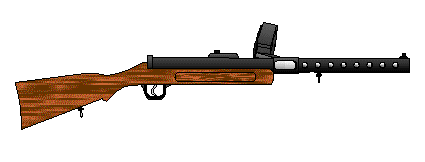 During the
great German offensive of 1918, wherever supplies would allow, German Sturmtruppen carried the new,
9-mm MP-18 Bergmann submachine gun rather than the long, bolt-action Mauser rifle. American troops went into
action with the M1918 Winchester "trench rifle," a short-barreled, slide-action, 12-gauge shotgun with
a lengthened magazine and a bayonet mount ("trench rifle" was a euphemism adopted in deference to Hague
Convention prohibitions on military use of shotguns). Light machineguns—the Allied Lewis and the German
Madsen and LMG 08—were more widely issued than before and were treated as mobile, offensive weapons rather
than as static, defensive assets. American troops were expected to have the first examples of the still
lighter Browning BAR by the end of the year. Tanks now replaced artillery as the main wire- and trench-
breaching tool in the minds of commanders.
During the
great German offensive of 1918, wherever supplies would allow, German Sturmtruppen carried the new,
9-mm MP-18 Bergmann submachine gun rather than the long, bolt-action Mauser rifle. American troops went into
action with the M1918 Winchester "trench rifle," a short-barreled, slide-action, 12-gauge shotgun with
a lengthened magazine and a bayonet mount ("trench rifle" was a euphemism adopted in deference to Hague
Convention prohibitions on military use of shotguns). Light machineguns—the Allied Lewis and the German
Madsen and LMG 08—were more widely issued than before and were treated as mobile, offensive weapons rather
than as static, defensive assets. American troops were expected to have the first examples of the still
lighter Browning BAR by the end of the year. Tanks now replaced artillery as the main wire- and trench-
breaching tool in the minds of commanders.
The new weaponry produced something of a tactical quandary for German and Allied staff officers.
While hastily emplaced field guns and armor-piercing, 7.92-mm K-type ammunition had kept the
first generation of tanks from achieving decisive results, it was now clear that even the existing armor
could achieve major breakthroughs when deployed in sufficient numbers and supported by infantry and guns.
Better protection and improved mechanical reliability would eliminate most of the tanks' weaknesses. On the
other hand, it was no less clear that a break in the lines would not, on its own, win battles under the conditions
prevailing in 1918 and 1919. During the German offensive of 1918, small, highly motivated, lightly equipped
units of Sturmtruppen had penetrated Allied lines with relative ease. But the Allied armies had not
disintegrated. Observers in both camps noted that, wherever clerks, cooks, and stragglers rallied around a
field kitchen or an isolated strip of ruined trench, the infiltrators suffered grievously, slowed, and, as
often as not, fell victim to organized counterattacks. The multiplication of small defended points caused
delays, and delay was the isolated, lightly loaded storm trooper's deadliest enemy. This lesson led both
sides to develop formidable defenses in depth. The old, shallow trench lines were replaced by deep,
discontinuous belts of strongpoints, arranged for all-around fire and mutual support. On the German side,
where this trend was most pronounced, concrete pillboxes and shell-proof infantry shelters shared
interlocking fields of fire. Mine fields, wire, and antitank ditches 20 to 30 feet across channeled
attackers into fire lanes where pre-laid artillery and machine-gun fire could annihilate them. It was
thus clear that the new weapons and tactics could easily replace the 1914-17 stalemate with another,
deadlier impasse. To achieve a decisive, war-winning breakthrough, the new weapons and tactics would have
to be combined under a new strategy, a strategy calculated to exploit their potential before they could
be countered.
Allied strategic thinking crystallized in Plan 1919. Plan 1919 originated in a paper written by
a junior staff officer in the British Army, J.F. C. Fuller. Fuller argued that, under the new conditions
prevailing on the battlefield in late 1918, breaching a defense line or routing and encircling an enemy
formation was no longer enough. Weakening the enemy by destroying his manpower and materiel—by attrition—
was demonstrably too costly and uncertain. Instead, Fuller proposed, the Allies should try what would
later be called a "decapitation" strategy in the Persian Gulf, a war directed at enemy command, control,
and communications. With its head cut off, the body of the German army would flounder about spasmodically
and ineffectually. Panic would set in, resistance would crumble, and the German war effort would rapidly
collapse.
Fuller envisioned a three-phase attack with each phase closely supported by aircraft. First, medium
tanks would infiltrate enemy lines on narrow fronts at two separate points, disorganizing German
command and control. There would be no preparatory bombardment to alert the defenses. Then a combined
force of infantry and heavy tanks would breach the disorganized German lines and reduce any strongpoints
that slowed the advance. Finally, medium tanks and cavalry would pour through the gaps created by the
assault and would sweep around the slow-moving defenders, destroying supply dumps, cutting telephone and
telegraph wires, tearing up rail lines, and overrunning artillery and command posts. For five to seven days,
the pursuit would continue, at a rate of 20 miles per day. The speed and power of the armored thrust would,
Fuller argued, allow the attack to succeed before the Germans could counterattack the long, exposed flanks of
the mobile columns. Mechanization would, in short, supply the speed and fire power that the foot-borne
Sturmtruppen had lacked.
Fuller's plan caught the imagination of the Allied supreme commander, Marshal Foch. Foch was
anxious for some way of breaking the stalemate in the trenches, without the grotesque waste of life
that had all too recently pushed many French units to the brink of mutiny. Embracing Fuller's vision,
the general swept aside the objections that had thus far fettered tank-minded officers in the
French army. Fuller's work was, in essence, adopted as the basis of the Allied strategy for winning
the war. To implement Plan 1919, Foch called for a 1919 Allied tank strength of 10,000 vehicles
of two basic types. For an assault on a 90-mile front, Fuller's original plan required 2592 heavy,
"breakthrough" tanks and 2400 medium, "exploitation tanks." But, with the exception of the excellent
Renault FT-17, the existing, 1916-type designs were clearly inadequate for the kind of battle that was
now envisioned. They broke down too often for deep penetrations and/or carried too little fuel and
ammunition for sustained operations. Habitability was terrible—exhaust fumes, noise, and labor-intensive
transmission and steering arrangements quickly left crews exhausted (no tank had so much as a firewall
between crew and engine before American automotive engineers added one to the American-built FT-17).
As assault vehicles, the early tanks lacked the armor and the trench-crossing ability that were now essential.
No one vehicle could fulfill all of these new demands, given the technology of the time. So a new,
mixed force of heavy, short-range assault tanks and fast, long-range mediums would be necessary.
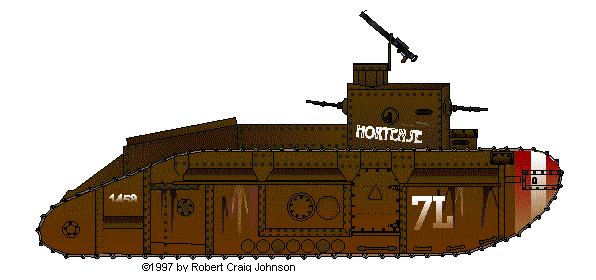 Tank, Medium C
Tank, Medium C
The first British medium, the Whippet, had proved barely adequate. It was fragile, hard to drive,
short-legged, and lacked the trench-crossing ability that the infiltration phase of the plan required.
Mediums would have to cross the formidable anti-tank ditches of the Hindenburg Line before they could
turn the German flanks and raid the headquarters areas at the rear. Accordingly, the new Medium B, Medium C,
and Medium D tanks adopted the rhomboidal form of the British heavies. While they retained the all-machine gun
armament and fixed turret of the Whippets, they were much larger, easier to handle, and better protected
vehicles. The the main breakthrough tank would be the Anglo-American Mark VIII "Liberty" or "International."
This was an enlarged and improved version of the rhomboid-type heavy tank, with better
track, greater trench-crossing ability, and a powerful Ricardo or Liberty V-12 engine in a sealed engine
compartment. The armor was designed to withstand the German K-patrone and the bullet splash (molten
lead) that forced its way through the joints and vision slits of the earlier vehicles. The Mark VIII
went into production in the US, but did not see combat. They formed a major part of the US Army's nominal
tank strength up until 1940, when they were quietly sent to Canada for use in training. Examples can
still be seen at the Aberdeen and Bovington tank museums.
 Tank, Mark VIII, the "Liberty" or "International" as it might have looked
in action during 1919.
Tank, Mark VIII, the "Liberty" or "International" as it might have looked
in action during 1919.
The French were to produce International tanks for their units. But, typically, they also developed
breakthrough tanks of their own. These were rather more ambitious than the Mk. VIII, and none actually
appeared prior to the mid-1920s. The furthest advanced was the Char 2C, in effect a greatly enlarged
and lengthened, multi-turret FT-17. It had a 75-mm field gun in the rotating, forward turret and a 7.5-mm
machine gun in separate, rear-mounted turret. The latter was intended to enfilade trenches as the tank
crossed. Additional machine guns fired from ball mounts on the flanks of the vehicle. Ten were
eventually built between 1920 and 1925. All were destroyed on their railroad flatcars while being
rushed to the front in 1940. The illustration shows how the vehicle might have appeared in
action in 1919.
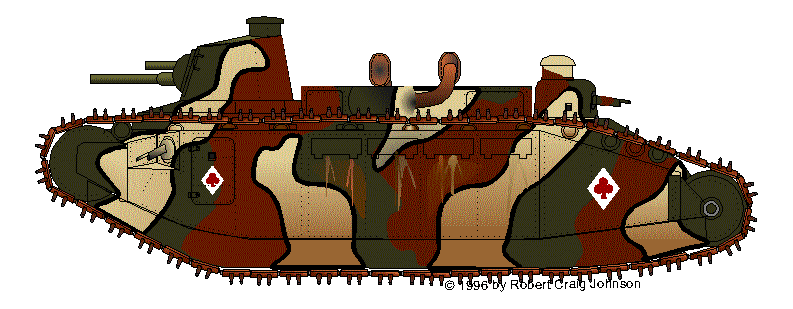 Char de rupture 2C
Char de rupture 2C
Better tanks were not, however, the whole answer to the problems of the late-war battlefield. Plan
1919 thus built on experience gained from the first major tank actions—Cambrai, Amiens, Villers-
Bretonneux. In each of these seminal battles, tanks had achieved major breakthroughs and thoroughly
disorganized the German defenses. But, just when victory seemed in reach, the offensives had, in each case,
faltered. Tanks broke down, got lost, or fell victim to well-sited field guns. The artillery
that would normally have neutralized the enemy guns and the flow of orders, supplies, and spare parts
that would sustain and guide a conventional advance had been rapidly left behind in the mud of the shattered
German defence lines. Poor communications and the inability of artillery to keep up were, by 1918,
the main limiting factor on the success of tank offensives.
Fuller addressed these problems by suggesting a greater reliance on aircraft than had hitherto
been the norm. Bombers would isolate the battlefield by disorganizing enemy communications, attacking
headquarters, and bombing road junctions. Fighters would serve in lieu of field artillery during the advance.
They would use their machine guns and 20-lb Cooper bombs to pin down antitank artillery, thus securing
the fast and, hopefully, reliable medium tanks against their most dangerous enemy. Fighters would also
strafe rolling stock, road transport, and assembling reinforcements in the rear. Most importantly of all,
"contact patrol" aircraft would take over for the supply train and the field telephone network that the
fast moving assault forces had left behind. These airplanes would locate friendly forces and front
lines, pick up messages, and drop orders and supplies to temporarily isolated units.
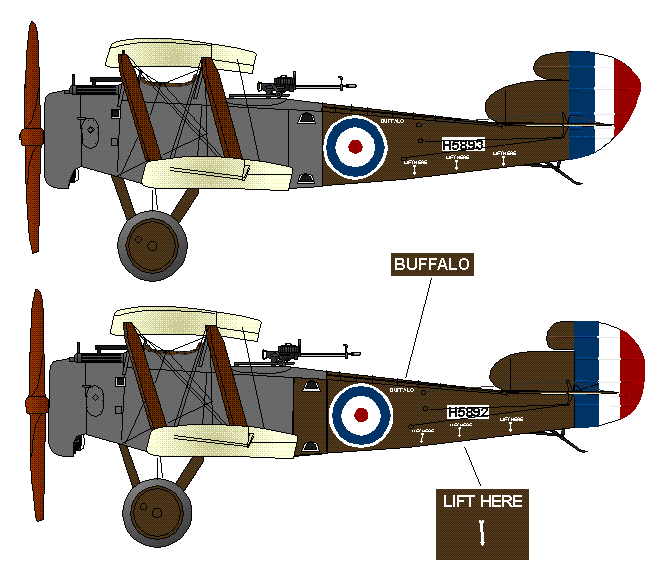 Sopwith Buffalo armored contact patrol prototypes, 1918
Sopwith Buffalo armored contact patrol prototypes, 1918
The contact patrol type was, in many ways, the most characteristic aircraft to emerge from the First
World War, even though it appeared in only limited numbers and at the very end of the fighting. Radio
telephony was still in its experimental stages in 1918, so troops communicated with aircraft using Very lights
and pre-arranged patterns of cloth staked out on the ground. To locate small, camouflaged units of
friendly troops on a rapidly changing, discontinuous front, contact patrol aircraft thus had to fly slowly,
close to the ground, where enemy fire was heaviest. When ordinary two-seaters were used in this role,
casualties were heavy and useful information scarce. The obvious answer was a well-armored two-seater—
the contact patrol machine.
Germany's AEG, Albatros, and all-metal Junkers J-1 airplanes were the only contact patrol types to see
active service. But the first Allied equivalent, the Sopwith Buffalo (illustrated above) was just entering
large-scale production when the Armistice was signed. The prototype, H.5892, was, in fact, sent to France
for testing but did not fly operationally. The Buffalo closely resembled Sopwith's Snipe and
Salamander fighters. It shared the same engine—the 230-hp Bentley BR.2—and had roughly similar two-bay
wings and balanced tail surfaces. The Buffalo was, however, a two-seater. The pilot sat high up under
a large cut-out in the upper wing, back-to-back with the observer/gunner. A single, fixed, .303-cal Vickers
machine gun was mounted in the upper engine decking for the pilot, and the observer had a single Lewis gun
on a Sopwith pillar mount (on the first prototype) or Scarf ring (all others). The entire forward fuselage,
from the rear of the observer's cockpit to the engine was fabricated from flat sheets of armor plate. Weight
was, of course, a problem. The Buffalo weighed 2,178 lbs empty (vs. 1329 lbs for the similarly powered Snipe).
With a 360-lb crew, 375 lbs of fuel and lubricant, and a military load of 158 lbs, the airplane tipped the
scales at 3071 lbs. While it had a respectable speed for a two-seater, 114 mph at 1000 ft, climb rate was poor
and control response sluggish. It was seriously under-powered. Still, in the absence of higher-powered
engines, the aircraft was felt to be adequate for service use, given the urgency of the need.
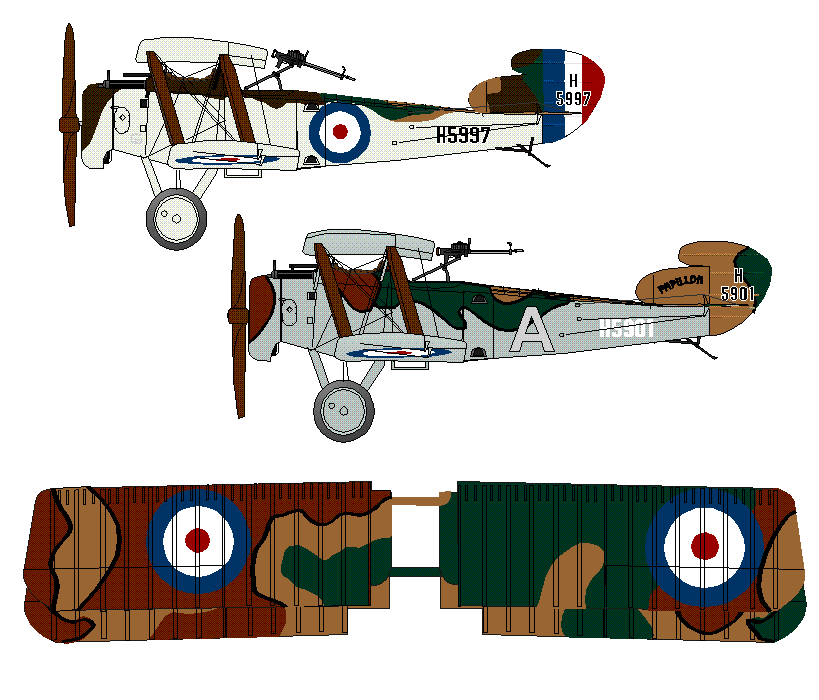 Hypothetical operational Buffalos, 1919. The camouflage schemes were developed for
close support airplanes in 1918 and were tested on Salamanders.
Hypothetical operational Buffalos, 1919. The camouflage schemes were developed for
close support airplanes in 1918 and were tested on Salamanders.
The flying artillery for Plan 1919 was to be Sopwith's TF.2 Salamander, the "Trench-Fighter" counterpart
to the Buffalo. It was essentially a Snipe with a slab-sided armored fuselage and extra machine-gun
ammunition (1000 rounds per gun vs. 500 for the Snipe). The armor weighed 650 lb and enclosed both the
pilot and the fuel tanks. The substantially smaller area of armor required by a single seater was less of
a problem for the Bentley BR.2. Performance was very good close to the ground, so good, in fact, that some
thought was given to adopting the Salamander as the RAF's standard post-war fighter, in place of the Snipe.
Top speed was 125 mph at 500 ft, higher than the Snipe's maximum, 121 mph at 10,000 ft. Handling was good.
By 1918, 1100 Salamanders were on order, 102 were complete, and 37 had been accepted by the RAF. But only two
had reached France. None saw action prior to the Armistice, though some were reportedly mobilized during
the Chanak Crisis of 1919. Several were used to develop camouflage schemes and multiple-gun armament
arrangements (one carried 8 .303-cal guns, firing downward).
The anticipated proliferation of armored Allied airplanes naturally provoked counter-measures. Germany
developed its own armored trench fighters in 1918, and tasked them with attacking Allied trench fighters
and contract patrol aircraft. The first attempt at an aircraft in this class was the AEG PE (Panzer
Einsitzer) triplane, which was not accepted. But its successor, the AEG DJ.1, was ordered into
production. The DJ.1 was a structurally advanced two-bay biplane powered by the new 195-hp Benz Bz III
or Maybach Mb IVa V-8 engine. The airframe was fabricated from dural light alloy with fabric covered
flying surfaces and a dural-sheet fuselage. To reduce vulnerability to ground fire, there were no bracing
wires. The wings were braced to each other and to the fuselage by substantial, I-section struts. Armor
protected the pilot, fuel tanks, and engine. Initially, the fighter was to carry two standard 7.92-mm
machine guns and light bombs. But it was also designed to incorporate the formidable TuF (Tank und
Flieger Gewehr), a heavy antitank machine gun chambered for the 13-mm Mauser cartridge described below.
Three prototypes were under test when the war ended in the West. The Benz-engined aircraft attained a
maximum speed of 112 mph. They weighed 2606 lbs empy and 3,031 lbs fully loaded. Span was 32 ft 9 in and
length was 21 ft 11 in.
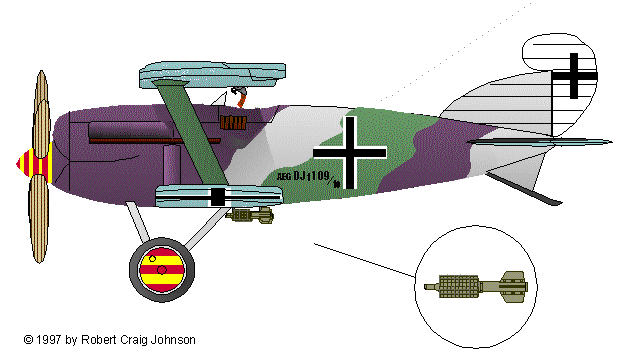 AEG DJ.1 in imaginary Schlasta markings.
AEG DJ.1 in imaginary Schlasta markings.
Lacking tanks or the industrial capacity to produce them in any numbers in the near term,
Germany naturally concentrated on developing antitank weapons.  For the infanrymen, a 13-mm cartridge was developed to replace the K-patrone.
A dedicated, bolt-action, Mauser antitank rifle was developed for the new round, together with the formidable
TuF machine gun. The rifle saw limited service before the war ended, but the dual-purpose, anti-aircraft/
antitank machine gun encounterd problems. In any case, the 13-mm cartridge was of marginal effectiveness,
even in the near term, and the weapons designed for it were heavy and awkward to fire. For the increasingly
fluid defensive battles of 1919, some more mobile, more flexible answer to the tank was clearly needed.
For the infanrymen, a 13-mm cartridge was developed to replace the K-patrone.
A dedicated, bolt-action, Mauser antitank rifle was developed for the new round, together with the formidable
TuF machine gun. The rifle saw limited service before the war ended, but the dual-purpose, anti-aircraft/
antitank machine gun encounterd problems. In any case, the 13-mm cartridge was of marginal effectiveness,
even in the near term, and the weapons designed for it were heavy and awkward to fire. For the increasingly
fluid defensive battles of 1919, some more mobile, more flexible answer to the tank was clearly needed.
The aircraft emerged as the chosen weapon. The high-performance AEG G.IV medium bomber was converted
into an armored, antitank gunship, the G.IVk (kanone). Armor enclosed both engines and the entire
forward half of the fuselage. Two of the new SEMAG/Becker automatic cannon were mounted, one in a fully
enclosed turret under the nose and on an open, large-diameter gun ring on the rear cockpit. The Becker was
the first 20-mm light-weight cannon, the direct ancestor of the Second-War Oerlikon. It could easily pierce
any World War I tank, particularly from above. Performance was adequate, though probably not stellar. Like
its Second-War and modern-day counterparts, the AEG gunship would probably have suffered severely had it been
called on to support German offensive thrusts in the face of Allied fighters. But, like the Henschel Hs 129,
it would have acquitted itself well as a container of break throughs, hunting Fuller's rampaging
medium tanks in the German rear. A number were produced prior to the end of the war, but their is no evidence
that they were ever used.
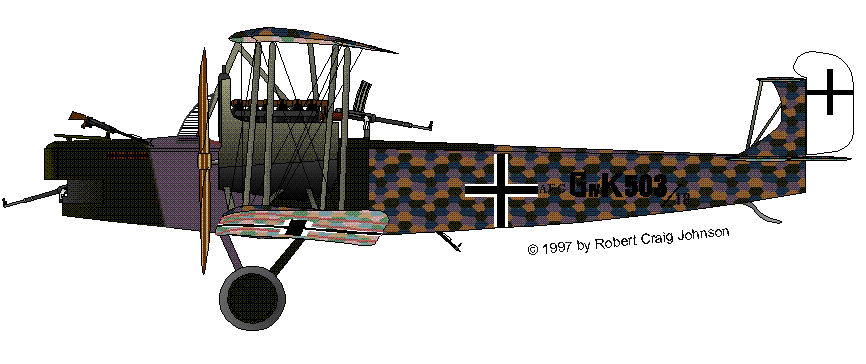 AEG G.IVk in production markings, 1918.
AEG G.IVk in production markings, 1918.
Plan 1919 was never put into effect, of course, and the anticipated, German defensive measures likewise
came to nought. With the fifth winter of the war rapidly approaching, Germany lacked even the fundamental
elements of survival, food and fuel. Skilled workmen had been fed into the extravagant slaughter on the
Western Front, leaving the factories to their wives and children and to the disaffected war invalids who had
preceded them at the front. The shadow workforce that remained was freezing and starving. Under such conditions,
the high command's ambitious plans for new weapons production were utterly unrealistic, even if the workers
had been amenable. They were not. In sheer desperation, trades unionists, social democrats, socialists,
and Marxist Spartacists challenged the military for control of the nation. Strikes and street
demonstrations broke out across Germany and Austro-Hungary. When the long-idle, ill-fed, disaffected sailors
of the High Seas fleet were called out to suppress uprisings in Kiel and Berlin, they mutinied, fought the
police, and distributed weapons to the crowds. This sudden threat to the established social order and to the
predominance of the Army in public life achieved what the inexorably growing strength of the Allies could not:
it convinced Germany's generals to sue for peace, at almost any price. They had to disengage so that the
disciplined, politically ignorant, isolated fighting troops could be thrown against the starving and rebellious
citizenry of their country. The November 11, 1918 Armistice thus became, ironically, the saviour of the
Teutonic militarism that would re-emerge so catastrophically twenty years later, and the German democracy that
would later be proclaimed at Versailles would be killed at birth by cannon and flamethrowers in the
streets of Germany's cities.
Sources
The sources for this essay were too numerous and varied to conveniently list them here. Interested readers
should, however, feel free to contact the Editor with specific
bibliographic questions.
Next page
Return to Table of Contents
© 1997 by Robert Craig Johnson
 During the
great German offensive of 1918, wherever supplies would allow, German Sturmtruppen carried the new,
9-mm MP-18 Bergmann submachine gun rather than the long, bolt-action Mauser rifle. American troops went into
action with the M1918 Winchester "trench rifle," a short-barreled, slide-action, 12-gauge shotgun with
a lengthened magazine and a bayonet mount ("trench rifle" was a euphemism adopted in deference to Hague
Convention prohibitions on military use of shotguns). Light machineguns—the Allied Lewis and the German
Madsen and LMG 08—were more widely issued than before and were treated as mobile, offensive weapons rather
than as static, defensive assets. American troops were expected to have the first examples of the still
lighter Browning BAR by the end of the year. Tanks now replaced artillery as the main wire- and trench-
breaching tool in the minds of commanders.
During the
great German offensive of 1918, wherever supplies would allow, German Sturmtruppen carried the new,
9-mm MP-18 Bergmann submachine gun rather than the long, bolt-action Mauser rifle. American troops went into
action with the M1918 Winchester "trench rifle," a short-barreled, slide-action, 12-gauge shotgun with
a lengthened magazine and a bayonet mount ("trench rifle" was a euphemism adopted in deference to Hague
Convention prohibitions on military use of shotguns). Light machineguns—the Allied Lewis and the German
Madsen and LMG 08—were more widely issued than before and were treated as mobile, offensive weapons rather
than as static, defensive assets. American troops were expected to have the first examples of the still
lighter Browning BAR by the end of the year. Tanks now replaced artillery as the main wire- and trench-
breaching tool in the minds of commanders. 





 For the infanrymen, a 13-mm cartridge was developed to replace the K-patrone.
A dedicated, bolt-action, Mauser antitank rifle was developed for the new round, together with the formidable
TuF machine gun. The rifle saw limited service before the war ended, but the dual-purpose, anti-aircraft/
antitank machine gun encounterd problems. In any case, the 13-mm cartridge was of marginal effectiveness,
even in the near term, and the weapons designed for it were heavy and awkward to fire. For the increasingly
fluid defensive battles of 1919, some more mobile, more flexible answer to the tank was clearly needed.
For the infanrymen, a 13-mm cartridge was developed to replace the K-patrone.
A dedicated, bolt-action, Mauser antitank rifle was developed for the new round, together with the formidable
TuF machine gun. The rifle saw limited service before the war ended, but the dual-purpose, anti-aircraft/
antitank machine gun encounterd problems. In any case, the 13-mm cartridge was of marginal effectiveness,
even in the near term, and the weapons designed for it were heavy and awkward to fire. For the increasingly
fluid defensive battles of 1919, some more mobile, more flexible answer to the tank was clearly needed.